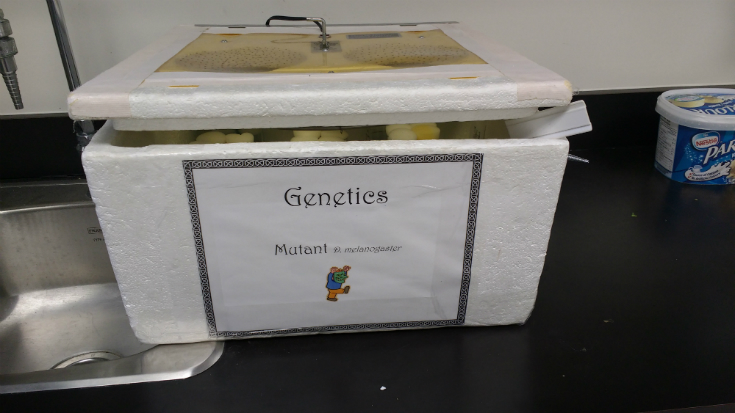Jonathan Kornelsen, a UWinnipeg Sir William Stephenson Scholar, is finishing up his education practicum teaching biology at West Kildonan High School. With the help of professors and staff members at UWinnipeg, he is making the study of genetics more interesting for his students.

Jonathan Kornelson, © UWinnipeg
“While getting a degree in biology at the UWinnipeg, my most memorable learning experiences happened in science labs and on summer research projects,” Kornelson said. “I wanted to give Grade 12 students a chance at doing a genetics study that would connect science theory with science practice.”
Kornelson recalled a classic experiment that he did at UWinnipeg with Drosophila melanogaster, commonly known as fruit flies. The fruit fly is one of the most powerful tools that geneticists can use to examine the relationship between genotype (a set of genes responsible for a trait) and phenotype (the observable or expressed traits of an organism). Thanks to their high reproductive capacity and short generation time, Drosophila species can be readily grown in a laboratory or classroom, so they are ideal for the science lessons Kornelson wanted to conduct.
Last fall Kornelson contacted his former biology professor, Dr. Beata Biernacka, to see if he could have a batch of fruit flies to use in his class to show how genetics works. Biernacka put Kornelson in touch with UWinnipeg physiological technologist Desiree Nickel.
Nickel is responsible for setting up several teaching labs in the biology department. She keeps specialized equipment in working order, maintains supply inventories of chemicals, solutions, glassware, and organisms (live or preserved), and makes sure the instructors and students have everything they need to work safely in the lab.

Desiree Nickel, © UWinnipeg
“When Dr. Biernacka passed Jonathan’s email to me I was more than happy to help him introduce fruit flies to his students,” said Nickel, who gave him a batch of fruit flies. “I basically went over all of the things to consider when getting together experimental supplies and planning according to life cycle of the organism. We also discussed student-safe anesthesia of the flies (ice bath) and the proper discard methods for old stock vials and flies.”
Nickel looks after several insect colonies, including the fruit flies. “I maintain and expand the Drosophila melanogaster (fruit fly) strains as needed, and for the animal physiology lab I maintain a colony of Madagascar Hissing Cockroaches,” Nickel said. “We also have recently acquired a family (a dozen or so) of stick insects from a resourceful student in our invertebrates lab.”
Kornelson’s Grade 12 class experiment ran over a six-week period. Students were provided with two stocks of flies — a wild type (normal phenotype) and a mutant strain with altered wing morphology. Students crossed the different strains, and then recrossed the offspring to examine patterns of inheritance. The process was so successful Kornelson is running the experiment again with another Grade 12 class this spring.









